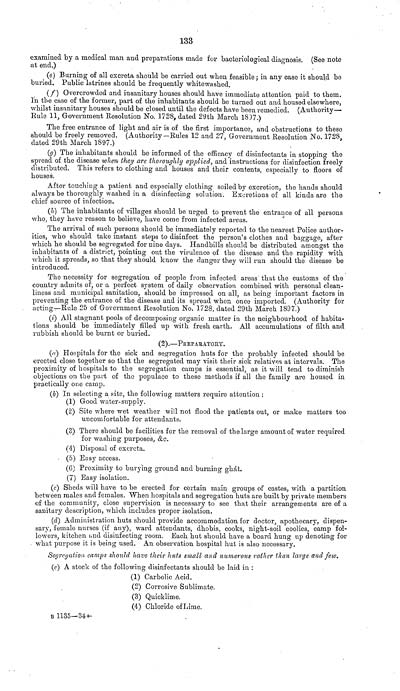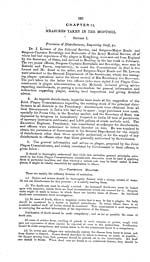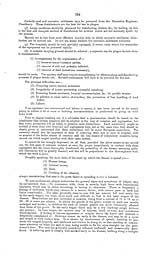Medicine - Disease > Account of plague administration in the Bombay Presidency from September 1896 till May 1897
(145) Page 133
Download files
Individual page:
Thumbnail gallery: Grid view | List view

133
examined by a medical man and preparations made for bacteriological diagnosis. (See note
at end.)
(e) Burning of all excreta should be carried out when feasible; in any case it should be
buried. Public latrines should be frequently whitewashed.
(f) Overcrowded and insanitary houses should have immediate attention paid to them.
In the case of the former, part of the inhabitants should be turned out and housed elsewhere,
whilst insanitary houses should be closed until the defects have been remedied. (Authority-
Rule 11, Government Resolution No. 1728, dated 29th March 1897.)
The free entrance of light and air is of the first importance, and obstructions to these
should be freely removed. (Authority-Rules 12 and 27, Government Resolution No. 1728,
dated 29th March 1897.)
(g) The inhabitants should be informed of the efficacy of disinfectants in stopping the spread of the disease when they are thoroughly applied, and instructions for disinfection freely
distributed. This refers to clothing and houses and their contents, especially to floors of
houses.
After touching a patient and especially clothing soiled by excretion, the hands should
always be thoroughly washed in a disinfecting solution. Excretions of all kinds are the chief source of infection.
(h) The inhabitants of villages should be urged to prevent the entrance of all persons
who, they have reason to believe, have come from infected areas.
The arrival of such persons should be immediately reported to the nearest Police author-
ities, who should take instant steps to disinfect the person's clothes and baggage, after
which he should be segregated for nine days. Handbills should be distributed amongst the inhabitants of a district, pointing out the virulence of the disease and the rapidity with
which it spreads, so that they should know the danger they will run should the disease be
introduced.
The necessity for segregation of people from infected areas that the customs of the country admits of, or a perfect system of daily observation combined with personal clean-
liness and municipal sanitation, should be impressed on all, as being important factors in
preventing the entrance of the disease and its spread when once imported. (Authority for
acting-Rule 25 of Government Resolution No. 1728, dated 29th March 1897.)
(i) All stagnant pools of decomposing organic matter in the neighbourhood of habita-
tions should be immediately filled up with fresh earth. All accumulations of filth and
rubbish should be burnt or buried.
(2).-PREPARATORY.
(a) Hospitals for the sick and segregation huts for the probably infected should be
erected close together so that the segregated may visit their sick relatives at intervals. The
proximity of hospitals to the segregation camps is essential, as it will tend to diminish
objections on the part of the populace to these methods if all the family are housed in
practically one camp.
(b) In selecting a site, the following matters require attention;
(1) Good water-supply.
(2) Site where wet weather will not flood the patients out, or make matters too
uncomfortable for attendants.
(3) There should be facilities for the removal of the large amount of water required
for washing purposes, &c.
(4) Disposal of excreta.
(5) Easy access.
(6) Proximity to burying ground and burning ght.
(7) Easy isolation.
(c) Sheds will have to be erected for certain main groups of castes, with a partition
between males and females. When hospitals and segregation huts are built by private members
of the community, close supervision is necessary to see that their arrangements are of a
sanitary description, which includes proper isolation.
(d) Administration huts should provide accommodation for doctor, apothecary, dispen-
sary, female nurses (if any), ward attendants, dhobis, cooks, night-soil coolies, camp fol-
lowers, kitchen and disinfecting room. Each hut should have a board hung up denoting for
what purpose it is being used. An observation hospital hut is also necessary.
Segregation camps should have their huts small and numerous rather than large and few.
(c) A stock of the following disinfectants should be laid in:
(1) Carbolic Acid.
(2) Corrosive Sublimate.
(3) Quicklime.
(4) Chloride of Lime.
B 1135-34\?\
examined by a medical man and preparations made for bacteriological diagnosis. (See note
at end.)
(e) Burning of all excreta should be carried out when feasible; in any case it should be
buried. Public latrines should be frequently whitewashed.
(f) Overcrowded and insanitary houses should have immediate attention paid to them.
In the case of the former, part of the inhabitants should be turned out and housed elsewhere,
whilst insanitary houses should be closed until the defects have been remedied. (Authority-
Rule 11, Government Resolution No. 1728, dated 29th March 1897.)
The free entrance of light and air is of the first importance, and obstructions to these
should be freely removed. (Authority-Rules 12 and 27, Government Resolution No. 1728,
dated 29th March 1897.)
(g) The inhabitants should be informed of the efficacy of disinfectants in stopping the spread of the disease when they are thoroughly applied, and instructions for disinfection freely
distributed. This refers to clothing and houses and their contents, especially to floors of
houses.
After touching a patient and especially clothing soiled by excretion, the hands should
always be thoroughly washed in a disinfecting solution. Excretions of all kinds are the chief source of infection.
(h) The inhabitants of villages should be urged to prevent the entrance of all persons
who, they have reason to believe, have come from infected areas.
The arrival of such persons should be immediately reported to the nearest Police author-
ities, who should take instant steps to disinfect the person's clothes and baggage, after
which he should be segregated for nine days. Handbills should be distributed amongst the inhabitants of a district, pointing out the virulence of the disease and the rapidity with
which it spreads, so that they should know the danger they will run should the disease be
introduced.
The necessity for segregation of people from infected areas that the customs of the country admits of, or a perfect system of daily observation combined with personal clean-
liness and municipal sanitation, should be impressed on all, as being important factors in
preventing the entrance of the disease and its spread when once imported. (Authority for
acting-Rule 25 of Government Resolution No. 1728, dated 29th March 1897.)
(i) All stagnant pools of decomposing organic matter in the neighbourhood of habita-
tions should be immediately filled up with fresh earth. All accumulations of filth and
rubbish should be burnt or buried.
(2).-PREPARATORY.
(a) Hospitals for the sick and segregation huts for the probably infected should be
erected close together so that the segregated may visit their sick relatives at intervals. The
proximity of hospitals to the segregation camps is essential, as it will tend to diminish
objections on the part of the populace to these methods if all the family are housed in
practically one camp.
(b) In selecting a site, the following matters require attention;
(1) Good water-supply.
(2) Site where wet weather will not flood the patients out, or make matters too
uncomfortable for attendants.
(3) There should be facilities for the removal of the large amount of water required
for washing purposes, &c.
(4) Disposal of excreta.
(5) Easy access.
(6) Proximity to burying ground and burning ght.
(7) Easy isolation.
(c) Sheds will have to be erected for certain main groups of castes, with a partition
between males and females. When hospitals and segregation huts are built by private members
of the community, close supervision is necessary to see that their arrangements are of a
sanitary description, which includes proper isolation.
(d) Administration huts should provide accommodation for doctor, apothecary, dispen-
sary, female nurses (if any), ward attendants, dhobis, cooks, night-soil coolies, camp fol-
lowers, kitchen and disinfecting room. Each hut should have a board hung up denoting for
what purpose it is being used. An observation hospital hut is also necessary.
Segregation camps should have their huts small and numerous rather than large and few.
(c) A stock of the following disinfectants should be laid in:
(1) Carbolic Acid.
(2) Corrosive Sublimate.
(3) Quicklime.
(4) Chloride of Lime.
B 1135-34\?\
Set display mode to: Large image | Zoom image | Transcription
Images and transcriptions on this page, including medium image downloads, may be used under the Creative Commons Attribution 4.0 International Licence unless otherwise stated. ![]()
| India Papers > Medicine - Disease > Account of plague administration in the Bombay Presidency from September 1896 till May 1897 > (145) Page 133 |
|---|
| Permanent URL | https://digital.nls.uk/74517300 |
|---|




